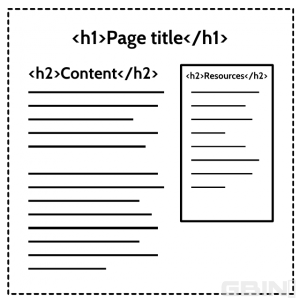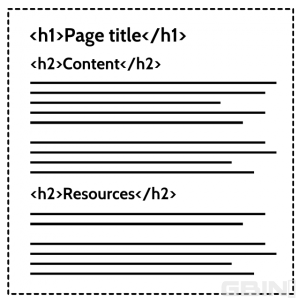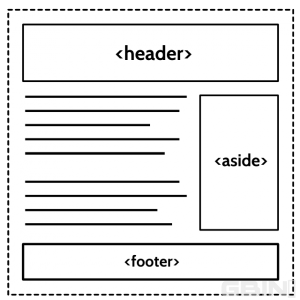不管你以前在web页面布局中如何称呼它们 - “区域”还是“块”,我们一直都在布局中将页面分成可视的不同区域。但真正的问题在于我们并没有使用任何正确的工具来实现。一般情况下我们使用典型的网格来划分页头,页面主题,页尾等等区域来实现所谓的页面布局。
在过去的很多年以来,我们都使用DIV来帮助我们划分页面区域,而为此我们定义了很多class来帮助我们有效定义页面上的每一个层次,最新的HTML5最终帮助我们解决了这个问题 - 使用section 元素, 很多人都非常喜欢这个新的HTML成员,因为i终于在HTML标准中给予了我们准确的开发建议,Section增强了整个DOM的可读性,在这篇文章中我 们将介绍这些新的元素,帮助我们了解能够解决什么问题,提供了什么重要的功能并且对于“语义化Web”做出了什么样的贡献!
开发网站
可能大家还记得使用dreamweaver来开发网站的日子,我们通过拖拽来生成一个典型的页面,如下:

使用dreamweaver只是为了快速的生成图形界面而非真正意义上的信息语义清晰,当然很多人都使用dreamweaver,包括我自己。典型的傻瓜式开发的产物。
web标准
当我们开始熟悉了web标准以及正确开发的相关最佳实践之后,我们需要做的事情仍旧是视觉设计,典型的“CSS布局”,尽量不使用语义错误的table来设 计页面布局。使用基于p的布局作为web设计其实已经很多年了,不过使用p布局导致document结构的混乱和层次的难于维护是显而易见的。而 且最恶心的hack问题也一直困扰我们!
Div标签的问题
每天都会有成千上万的开发人员使用p来分隔,格式化页面内容。我们使用p来分隔不同的内容区域,以保证内容的互相独立。但是事实上p并非用来实现这样的功能的。看看如下这个例子:

在这个简单的局部中,包含了一个文字主题和一个边栏内容。为了让它对于读者绝对清晰,我们将sidebar分离于主体。这里我们使用一个粗边框来封装这个边 栏内容。也许你会说,边栏的标题应该是
,这个我们稍后做解释。所有的定义使用了一个典型的CSS,如果你把CSS去除,你将看到如下 展示:

如果我去除了CSS,你看到页面布局变成了响应式风格,这其实就是HTML4 document如何在浏览器中实际被生成的样式。这里我们看到边栏区域其实是document中的另外一段信息。
为什么会这样呢?
主要的原因在于
是一个流动内容的元素。不管边框或者背景是什么样式,它和主题document并不分离,相反,作为其中的一个部分生 成。当我们移除CSS可以看到,边栏的“Resource”标题并非是一个独立的组件,而是document的一个部分。作为页面的阅读者来说,这一点大 家应该看到。
为了更好的说明,我们看看如下代码片段:
<div class="parent"> <h2>Heading</h2> <p>Some content...</p> <div class="child"> <h2>Another heading</h2> <p>Some other content...</p> </div> </div>
这里我们我们稍微的修改了一下内容,添加了两个p到来展示父子关系。 p.child标签属于p.parent。我们可以使用CSS来使得两个元素的关系看起来是这个样子。但是,要知道p在标准中的描述是“没什 么特殊含义”。非但不意味着任何语义上的含义,对于web页面的计算架构来说也没有任何意义。而且p对于我们来说也不可见。因此我们应该把他们都删 除,而使用如下4个元素来展示页面父子关系,如下:
<h2>Heading</h2> <p>Some content...</p> <h2>Another heading</h2> <p>Some other content...</p>
作为正确的结构来说,这里是实际构成内容的元素。
标题层次实际并非非常有用
可能很多人认为将
替换成
可能能够帮助我们解决问题。如果这样的话,我们可能得到如下:
A header(h2)
Another header(h3)
这个方式貌似更加的合理。但是实际上呢?h3的内容是否真的属于h2?这里很难说清楚。下面我们再看一个例子:
在这个HTML4页面中,我们使用h1来生成一个页面内容介绍标题,使用h2作为主内容的标题,使用h3来标示边栏,并且使用p#footer来生成页尾内容。但是问题是footer究竟属于那个一个内容呢?
Footer属于哪一个标题
下面这个图非常清晰的展示了document结构问题,我们看到这里footer究竟属于
的页尾,还是
的页尾。
可能有些专家认为,可以将代码改成如下样式:
h1(page)
h2(main)
h3(sidebar)
h2(footer)
这个属于一个hack,但是并非很正确。
划分区域
了解如何正确的划分区域,HTML5提供了

多选题:
A. 1 B. 2 C. 3 D. 4
你的答案是什么? 正确的应该是 (B)。
也许你会不太理解,因为在HTML5的标准中拥有有如下具体的定义:
4.4 Sections
4.4.1 body
4.4.2 nav
4.4.3 article
4.4.4 aside
4.4.5 h1, h2, h3, h4, h5 and h6
4.4.6 hgroup
4.4.7 header
4.4.8 footer
4.4.9 address
但是如果你看看 4.4.8 footer的时候,你会看到如下内容:
“the footer element is not sectioning content; it doesn’t introduce a new section.”
这里HTML5的定义上有一些前后矛盾之处,不过大家也不用过于纠缠。
Section是一个新类型的p吗?
这可能是一个典型的错误理解。
Div其实在功能上并没有任何含义,如果你使用p来创建页面框架结构将会是一个非常糟糕的选择。
而Section用来定义一个结构化的区域,看看下面这个例子:
<section class="outer"> <section class="inner"> <h1>Section title</h1> </section> </section>
这里我们使用section来生成一个盒模式。如果我们运行 our outliner,我们得到如下警告:
[Untitled Section]
Section title
这里如果使用p的话,可以有效帮助我们划分区域:
<section> <div> <h1>Section title</h1> </div> </section>
生成结果如下:
Section title
可以看到没有任何警告或者提示!
总结
HTML 并不是一个SDK或者图形设计师的画板。它是一个Meta语言,一个帮助你了解特殊信息的语言。有时候我们使用解析器,获取主体,时间,来源或者流行等内 容。这就是microdata和RDF主要的功能。另外,上下文,层次,相关的重要性和代码关系都需要被考虑。这就是正确的区域元素使用和语法需要考虑 的。
有些人可能会告诉你不要过于考虑区域,可能由于没有什么意义。但是使用区域定义很好的提高了HTML的结构,上面我们已经很好的介绍了。
个人认为,Section不但对于优化document结构来说有好处,而且最终会让整个DOM趋于合理。而同时对于我们来说需要去适应这种变化,需要我们 自己去优化和改变自己的开发流程和习惯,但是我相信对于web开发的趋势和方向来说,最终会使得整个流程更加专业和标准化。对于变化应该值得。
以上就是HTML5 区域(Sectioning)的重要性的内容,更多相关内容请关注PHP中文网(www.php.cn)!
 HTML5 and H5: Understanding the Common UsageApr 22, 2025 am 12:01 AM
HTML5 and H5: Understanding the Common UsageApr 22, 2025 am 12:01 AMThere is no difference between HTML5 and H5, which is the abbreviation of HTML5. 1.HTML5 is the fifth version of HTML, which enhances the multimedia and interactive functions of web pages. 2.H5 is often used to refer to HTML5-based mobile web pages or applications, and is suitable for various mobile devices.
 HTML5: The Building Blocks of the Modern Web (H5)Apr 21, 2025 am 12:05 AM
HTML5: The Building Blocks of the Modern Web (H5)Apr 21, 2025 am 12:05 AMHTML5 is the latest version of the Hypertext Markup Language, standardized by W3C. HTML5 introduces new semantic tags, multimedia support and form enhancements, improving web structure, user experience and SEO effects. HTML5 introduces new semantic tags, such as, ,, etc., to make the web page structure clearer and the SEO effect better. HTML5 supports multimedia elements and no third-party plug-ins are required, improving user experience and loading speed. HTML5 enhances form functions and introduces new input types such as, etc., which improves user experience and form verification efficiency.
 H5 Code: Writing Clean and Efficient HTML5Apr 20, 2025 am 12:06 AM
H5 Code: Writing Clean and Efficient HTML5Apr 20, 2025 am 12:06 AMHow to write clean and efficient HTML5 code? The answer is to avoid common mistakes by semanticizing tags, structured code, performance optimization and avoiding common mistakes. 1. Use semantic tags such as, etc. to improve code readability and SEO effect. 2. Keep the code structured and readable, using appropriate indentation and comments. 3. Optimize performance by reducing unnecessary tags, using CDN and compressing code. 4. Avoid common mistakes, such as the tag not closed, and ensure the validity of the code.
 H5: How It Enhances User Experience on the WebApr 19, 2025 am 12:08 AM
H5: How It Enhances User Experience on the WebApr 19, 2025 am 12:08 AMH5 improves web user experience with multimedia support, offline storage and performance optimization. 1) Multimedia support: H5 and elements simplify development and improve user experience. 2) Offline storage: WebStorage and IndexedDB allow offline use to improve the experience. 3) Performance optimization: WebWorkers and elements optimize performance to reduce bandwidth consumption.
 Deconstructing H5 Code: Tags, Elements, and AttributesApr 18, 2025 am 12:06 AM
Deconstructing H5 Code: Tags, Elements, and AttributesApr 18, 2025 am 12:06 AMHTML5 code consists of tags, elements and attributes: 1. The tag defines the content type and is surrounded by angle brackets, such as. 2. Elements are composed of start tags, contents and end tags, such as contents. 3. Attributes define key-value pairs in the start tag, enhance functions, such as. These are the basic units for building web structure.
 Understanding H5 Code: The Fundamentals of HTML5Apr 17, 2025 am 12:08 AM
Understanding H5 Code: The Fundamentals of HTML5Apr 17, 2025 am 12:08 AMHTML5 is a key technology for building modern web pages, providing many new elements and features. 1. HTML5 introduces semantic elements such as, , etc., which enhances web page structure and SEO. 2. Support multimedia elements and embed media without plug-ins. 3. Forms enhance new input types and verification properties, simplifying the verification process. 4. Offer offline and local storage functions to improve web page performance and user experience.
 H5 Code: Best Practices for Web DevelopersApr 16, 2025 am 12:14 AM
H5 Code: Best Practices for Web DevelopersApr 16, 2025 am 12:14 AMBest practices for H5 code include: 1. Use correct DOCTYPE declarations and character encoding; 2. Use semantic tags; 3. Reduce HTTP requests; 4. Use asynchronous loading; 5. Optimize images. These practices can improve the efficiency, maintainability and user experience of web pages.
 H5: The Evolution of Web Standards and TechnologiesApr 15, 2025 am 12:12 AM
H5: The Evolution of Web Standards and TechnologiesApr 15, 2025 am 12:12 AMWeb standards and technologies have evolved from HTML4, CSS2 and simple JavaScript to date and have undergone significant developments. 1) HTML5 introduces APIs such as Canvas and WebStorage, which enhances the complexity and interactivity of web applications. 2) CSS3 adds animation and transition functions to make the page more effective. 3) JavaScript improves development efficiency and code readability through modern syntax of Node.js and ES6, such as arrow functions and classes. These changes have promoted the development of performance optimization and best practices of web applications.


Hot AI Tools

Undresser.AI Undress
AI-powered app for creating realistic nude photos

AI Clothes Remover
Online AI tool for removing clothes from photos.

Undress AI Tool
Undress images for free

Clothoff.io
AI clothes remover

Video Face Swap
Swap faces in any video effortlessly with our completely free AI face swap tool!

Hot Article

Hot Tools

MantisBT
Mantis is an easy-to-deploy web-based defect tracking tool designed to aid in product defect tracking. It requires PHP, MySQL and a web server. Check out our demo and hosting services.

Dreamweaver Mac version
Visual web development tools

SublimeText3 Mac version
God-level code editing software (SublimeText3)

PhpStorm Mac version
The latest (2018.2.1) professional PHP integrated development tool

WebStorm Mac version
Useful JavaScript development tools






